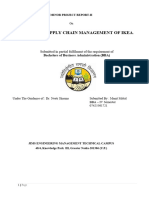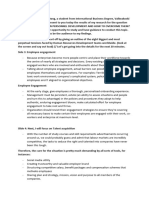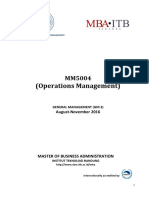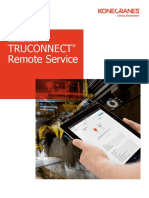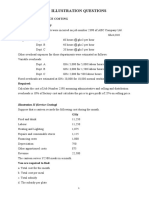Entr 1013 Week 13 Module
Entr 1013 Week 13 Module
Uploaded by
2203003Copyright:
Available Formats
Entr 1013 Week 13 Module
Entr 1013 Week 13 Module
Uploaded by
2203003Original Description:
Original Title
Copyright
Available Formats
Share this document
Did you find this document useful?
Is this content inappropriate?
Copyright:
Available Formats
Entr 1013 Week 13 Module
Entr 1013 Week 13 Module
Uploaded by
2203003Copyright:
Available Formats
UNIVERSITY OF SAINT LOUIS
Tuguegarao City
SCHOOL OF ACCOUNTANCY, BUSINESS and HOSPITALITY
Second Semester
A.Y. 2020-2021
CORRESPONDENCE LEARNING MODULE
ENTR 1013 – The Entrepreneurial Mind
Prepared by:
CAMILLE JAM L. SERA
MARY ANN C. BARTOLOME, MBE
Reviewed by:
MARY ANN C. BARTOLOME, MBE
Business Administration Program Chair
Recommended by:
ALICIA SILVA-TULIAO, MBE
Academic Dean
Approved by:
EMMANUEL JAMES PATTAGUAN, Ph.D.
Vice President for Academics
ENTR 1013 – The Entrepreneurial Mind | 1
School of Accountancy, Business and Hospitality
Business Administration Department
Curriculum 2019-2020
CORRESPONDENCE LEARNING MODULE
ENTR 1013 – The Entrepreneurial Mind
This Weeks’ Time Table: April 26-30, 2021
For this week, the following shall be your guide for the different lessons and tasks that you need to accomplish.
Be patient, read them carefully before proceeding to the tasks expected of you.
HAVE A FRUITFUL LEARNING EXPERIENCE 😊
Date Topics Activities or Tasks
April 26-27 Gate 3 – Execution: Machinery, Read Lessons
Methods and Management Skills This is NOT included in your Midterm Exam.
Machinery
Methods
Opportunity Seizing via Operating
Model
Management Skills
Putting the Operating Model
Together
April 28, 29, MIDTERM EXAM Please follow your schedule during Prelims.
Good Luck and God Bless 😊
30
ENTR 1013 – The Entrepreneurial Mind | 2
CORRESPONDENCE LEARNING MODULE
ENTR 1013 – The Entrepreneurial Mind
AY 2020-2021
Lesson 13: Gate 3 – Execution
Topic: Machinery, Methods and Management Skills
Learning Outcomes: At the end of this module, you are expected to:
1. Stimulate creativity and critical thinking in identifying opportunities and apply innovative approaches
in envisioning one’s entrepreneurial career.
2. Formulate business strategies to create value.
3. Gain knowledge in handling people, handling rewards and acquire leadership skills.
LEARNING CONTENT
Introduction:
It is only after all the tasks behind the four “gates” are accomplished that prosperity and success can be
attained.
We are already done with the first two gates; we are now going to proceed to the next gate. The third gate is
the execution gate, composed of machinery, methods and management skills. Value is actually created when
formulated strategies are executed.
Machinery is having an organization that can deliver its intended value. Methods, on the other hand, are
processes that institutionalize what needs to be done efficiently and effectively, while management skills
entail knowledge of people handling and reward handling, and having leadership skills.
The entrepreneur needs emotional quotient, or EQ to build the right culture to get things done.
ENTR 1013 – The Entrepreneurial Mind | 3
Lesson Proper:
GATE 3 – Execution: Machinery, Methods, and Management Skills
“A mind that creates. A will that excels. A
heart that cares. A team that wins. An
institution that lasts. All for the Glory of
God.”
Abenson Group
Execution – is the practice side of managing activities, makes strategy come alive.
- A great combination of strategy and execution can reduce uncertainty, lower cost, meet targets faster
and can be a source of advantage.
- Good execution softens poor strategy and gives time for the management to see and correct its strat-
egy.
- It is therefore important to think of execution during strategy formulation and involve key people in exe-
cution from the beginning.
A. Machinery – is an organization structure that can deliver the value planned.
- Machinery or organization can only be articulated after the value proposition in the offering model is
defined.
- This means strategy is the key driver of structure and value is created only if the structure is in harmony
with strategy.
- This also means a change in strategy will necessitate a review of its organization design to avoid any
contradictions.
Structure must support growth strategy; hence if market segment growth mandate, different market
segments must get sufficient attention. On the other hand, if geographical expansion is the mandate,
organization must provide sufficient attention to geographical focus to attain competitive advantage.
B. Methods – are about systems and processes that allow the entrepreneur information and control.
1. A value chain is a way to look at two different types of business activities: the first action that
creates value for a customer and the following action that supports the execution of the first action.
For instance, a grocery store may determine that offering grocery delivery is the first action that will
create value for the customer. The following actions that support the grocery delivery may include
online ordering, same-day delivery, and scheduling automatic weekly delivery. These multiple
activities are linked together to create value for the customer.
Entrepreneurs should ask themselves two related questions:
1. What functions or business processes have to be done excellently to achieve sustainable com-
petitive advantage? (a value creation approach)
2. In what value chain activities would poor execution seriously weaken strategic success? (a
problem-solving approach)
ENTR 1013 – The Entrepreneurial Mind | 4
is the strategic linkage or a series of value-adding individual
activities required to create, produce and deliver products and
Value chain
services to the customer that is the total business plan to create
profit for the firm.
The value chain helps employees visualize and understand the role each department of an organization
plays meeting the needs of other departments. In short, the value chain describes the primary activities
needed to accomplish a firm’s task and asks the question “What’s the most efficient way to do what
needs to be done?”
- It is an expanded supply chain.
Example of the Value Chain of a Manufacturing Company
Distribut Supply End
Design Sourcing R&D Mfg Mktg Channel
ion Chain users
- The value chain above shows the flow from design to manufacturing as part of the pre-transaction
cluster; from marketing to channel as part of the transaction cluster before the end customers are
reached. Another channel can be created for after sales service as part of the post-transaction cluster.
The value chain is important especially for start-ups as it defines the time and effort required in each
stage of the value chain before products can be sold to a paying customer. The time and effort needed
also to estimate the cash flow required to get things going in the start-up.
The value chain of a company’s strategy that is differentiated will differ from the value chain if the
strategy is low cost. Differentiated versus low cost activities would be different in value and cost, hence,
can drive competitive advantage.
Materials – suppliers delivering orders is the most fundamental part in a value chain.
2. Value network / Ecosystem
o The value chain is an expanded supply chain. Value network, on the other hand, is an expanded
value chain that shows the involvement of other stakeholders in each value chain stage to co-
create value. It is also called the ecosystem.
With an online business model, members of the value chain need not have ownership of goods
before they can resell, unlike the old manufacturing model where goods are passed on from one
party to another.
Resources
a. Hard assets are physical (channel, infrastructure, technology), financial and intangible assets
(brand, IP, customer info)
b. Soft assets are human assets like relationships, skills, and knowledge.
3. Processes - transform inputs into outputs.
- Processes are critical repetitive tasks that are routinized to foster good strategy execution. It in-
cludes managerial processes, operational processes and support processes. They support the
value chain for better efficiency and effectiveness.
a. Managerial processes – govern the operation of a system such as corporate governance
(norms, metrics).
b. Operational processes – are the sequence of value-adding activities that function together
(known as value stream) that adds value to the core process.
ENTR 1013 – The Entrepreneurial Mind | 5
c. Support processes – are procedures that support the core process, and these are purchasing,
accounting, technical and recruitment.
Process can be improved with productivity tools whenever available. Entrepreneurs must involve their
team for inputs, must listen and be open-minded with feedback because team members who are
intimate or directly interacting with customers usually know the customers’ pain points than their
superiors, being the ‘sensors’ of the company. Ensuring the employees have a voice is a great way to
bond and identify talents within the company as well. Team members with sense making skills will be
useful as your company grows.
Begin with strategy-critical processes and ensure they are aligned with your value creation strategy.
Critical processes are the processes with the biggest effect on the attainment of goals, impact key
factors for success and business strategy, solve problems encountered from a customer’s perspective
or offer greater value for the firm.
While two different items, resources and processes are treated together in the business model because
they repeatedly deliver the value proposition and the value capture. They more focused the value
proposition, the better for resources and processes to execute. Key processes rely on resources to get
things done.
a. Capabilities
As mentioned, structure comes after strategy. While the offering model answers where the firm will win,
the operating model completes the picture by answering how the firm will win, identify capabilities
needed to create an advantage.
b. Complementors
Companies cannot do everything alone. They need other people to help them deliver the value
proposition. Other items, companies may want to do something fast but lacks the capabilities to do so.
Other times, outsourcing some functions appears to make more financial sense.
c. Configuration and Cost
Entrepreneurs are always reconfiguring how to grow revenues, increase differentiation, improve cash
position while reducing cost.
C. Management skills
Execution can be built via building infrastructure to increase capabilities, which are composed of
coordination, commitment and competencies.
a. People – sharing meaningfulness and pride in their work while accomplishing required tasks.
b. Rewards – attaining a sense of identity with financial blessings while accomplishing required
tasks.
c. Leadership – having a sincere sense of mission and purpose while practicing good
governance.
We will discuss more about Management Skills on the next chapter 😊
*** END of LESSON 13***
ENTR 1013 – The Entrepreneurial Mind | 6
Learning Task
Think of a past project you have planned that has failed or wasn’t as successful as you had hoped.
1. Identify the barriers of the execution. (Why it failed)
2. How would you address these barriers? (Solution)
3. What have you learned from those mistakes?
REFERENCES
Textbooks
Go, Josiah and Escareal-Go, Chiqui (2018) Entrepreneurship: Starting an Enterprise. Having an Innovation
Mindset
Online References
"What Is a Value Chain? - Definition, Analysis & Example." Study.com, 26 April 2017,
study.com/academy/lesson/what-is-a-value-chain-definition-analysis-example.html
Learning Materials
1. Worksheets
2. Module
ENTR 1013 – The Entrepreneurial Mind | 7
SCHOOL OF ACCOUNTANCY, BUSINESS and HOSPITALITY
Second Semester
A.Y. 2020-2021
CORRESPONDENCE LEARNING MODULE
ENTR 1013 – The Entrepreneurial Mind
Lesson 13
WORKSHEET – TASKS
NAME:
COURSE & YEAR:
INSTRUCTOR:
Learning Task
Think of a past project you have planned that has failed or wasn’t as successful as you had hoped.
1. Identify the barriers of the execution. (Why it failed)
2. How would you address these barriers? (Solution)
3. What have you learned from those mistakes?
ENTR 1013 – The Entrepreneurial Mind | 8
ENTR 1013 – The Entrepreneurial Mind | 9
You might also like
- A Framework For Success For Leaders Everywhere: Essential Roles TheDocument2 pagesA Framework For Success For Leaders Everywhere: Essential Roles Therollrams100% (3)
- Lesson13 - Gate 3 - ExecutionDocument5 pagesLesson13 - Gate 3 - ExecutionQueen ValleNo ratings yet
- Entr 1013 Week 12 ModuleDocument12 pagesEntr 1013 Week 12 ModuleKatrina MarzanNo ratings yet
- Notes 652 NewDocument8 pagesNotes 652 NewAris TimNo ratings yet
- KM Assignment 1Document3 pagesKM Assignment 1Ameer AkramNo ratings yet
- MGT-629/422 Operations and Supply Chain ManagementDocument4 pagesMGT-629/422 Operations and Supply Chain ManagementChaqib SultanNo ratings yet
- Week 10Document21 pagesWeek 10Arishragawendhra NagarajanNo ratings yet
- Midterm Exam AnswerDocument6 pagesMidterm Exam AnswerGrace MasdoNo ratings yet
- Lesson - 7 - Developingbusinessitstrategies - PPTX Filename UTF-8''Lesson 7 - DevelopingbusinessitstrategiesDocument44 pagesLesson - 7 - Developingbusinessitstrategies - PPTX Filename UTF-8''Lesson 7 - DevelopingbusinessitstrategiesDemart Vermin TapangNo ratings yet
- Unit I: Lesson 1 - Overview of Enterprise System, Evolution and BenefitsDocument233 pagesUnit I: Lesson 1 - Overview of Enterprise System, Evolution and BenefitsSocial MediaNo ratings yet
- E Business Project ReportDocument32 pagesE Business Project Reportprincexerox2No ratings yet
- Aditya GuptaDocument64 pagesAditya GuptaManit MittalNo ratings yet
- POM UNIT-5Document14 pagesPOM UNIT-5agarwalabhijeet9246No ratings yet
- Technology Innovation and Sustainable Enterprise - Technology InnovationDocument15 pagesTechnology Innovation and Sustainable Enterprise - Technology InnovationvijayalakshmisNo ratings yet
- 2 TMLDocument4 pages2 TMLnadia jalilNo ratings yet
- Gate 3 - Execution - Machinery, Methods, and Management SkillsDocument35 pagesGate 3 - Execution - Machinery, Methods, and Management SkillsJohn Nelo MorataNo ratings yet
- 01 LSCM Assignment ChandanDocument9 pages01 LSCM Assignment ChandanMuhammad ZohaibNo ratings yet
- UIN - Assessment Activity - Resubmission - Carmen HofmeesterDocument15 pagesUIN - Assessment Activity - Resubmission - Carmen HofmeesterCarmen HofmeesterNo ratings yet
- ON Knowledge ManagementDocument8 pagesON Knowledge ManagementNiyati SethNo ratings yet
- KM - MBA 3rd Sem MaterialDocument101 pagesKM - MBA 3rd Sem MaterialkunnisamiraNo ratings yet
- Mis 2B and 3Document8 pagesMis 2B and 3Beverly RuyanaNo ratings yet
- TB 1-ENG-TheoryAssignmet-Summary-Topic2-Group 2Document18 pagesTB 1-ENG-TheoryAssignmet-Summary-Topic2-Group 2D'Jitu PambudiNo ratings yet
- Management Fat !!Document55 pagesManagement Fat !!dandamrajuadityaNo ratings yet
- Operations ManagementDocument57 pagesOperations Managementpexoj69013No ratings yet
- GEntrep Chapter 8Document40 pagesGEntrep Chapter 8Xyrelle NavarroNo ratings yet
- Employee Knowledge Management at TechumshDocument13 pagesEmployee Knowledge Management at TechumshSharmilaNo ratings yet
- Case Analysis KM-Accenture RameshRaman 11MBA0089Document20 pagesCase Analysis KM-Accenture RameshRaman 11MBA0089Ramesh RamanNo ratings yet
- SPECIAL TOPICS For OMDocument10 pagesSPECIAL TOPICS For OMHazel Remo LajarcaNo ratings yet
- What Is A Business ModelDocument12 pagesWhat Is A Business ModelTehrani SanazNo ratings yet
- Mckinsey 7 S Framework IntroductionDocument5 pagesMckinsey 7 S Framework Introductionnemik patelNo ratings yet
- Assessing Retention KnowledgeDocument7 pagesAssessing Retention KnowledgesemerederibeNo ratings yet
- Old AssessmentDocument28 pagesOld AssessmentSamar AbdElMonsefNo ratings yet
- Chapter 5 ORGANIZATIONAL ANALYSIS AND COMPETITIVE ADVANTAGEDocument23 pagesChapter 5 ORGANIZATIONAL ANALYSIS AND COMPETITIVE ADVANTAGEjecille magalongNo ratings yet
- E Business and Its Role in Inventory Management1Document94 pagesE Business and Its Role in Inventory Management1lokesh_045No ratings yet
- Management Accounting and Control SystemDocument14 pagesManagement Accounting and Control SystembryenNo ratings yet
- A Study On The Effectiveness of Performance Appraisal at Quantum It InnovationsDocument79 pagesA Study On The Effectiveness of Performance Appraisal at Quantum It InnovationsShahzad SaifNo ratings yet
- The Value ChainDocument5 pagesThe Value ChainNehal AbdellatifNo ratings yet
- E-Learning 101:: Validation in A Tough EnvironmentDocument35 pagesE-Learning 101:: Validation in A Tough EnvironmentvijayakumarvarmaNo ratings yet
- Week 1Document13 pagesWeek 12100593No ratings yet
- Business ModelDocument13 pagesBusiness ModelJoahnna BraveNo ratings yet
- BrochureDocument14 pagesBrochureKarim SirNo ratings yet
- CH-2-Operations-StrategyDocument19 pagesCH-2-Operations-Strategypuskarbhatta002No ratings yet
- PM NotesDocument10 pagesPM Notespriyansh02.uiamsNo ratings yet
- Operation Mangement.Document10 pagesOperation Mangement.x7vk5vdfwNo ratings yet
- Introduction To e Business Project ReportDocument32 pagesIntroduction To e Business Project Reportdanishwi82% (39)
- TESCO Organization For AssignmentDocument27 pagesTESCO Organization For AssignmentM IsmailNo ratings yet
- Business Intelligence and Performance Management in Academic DisciplineDocument15 pagesBusiness Intelligence and Performance Management in Academic DisciplineRajan ChristianNo ratings yet
- Challenges in Personnel DevelopmentDocument5 pagesChallenges in Personnel DevelopmentTrang DangNo ratings yet
- Unit 2.1 PracticeDocument3 pagesUnit 2.1 PracticeAwaara AgentNo ratings yet
- Preliminary InvestigationDocument48 pagesPreliminary InvestigationJay ChauhanNo ratings yet
- Strategy ImplementationDocument10 pagesStrategy Implementationvairiah_k100% (1)
- University of Lucknow PPT On Strategic Cost AccountingDocument10 pagesUniversity of Lucknow PPT On Strategic Cost Accountingoffer manNo ratings yet
- Sujal Prasad Sarma ProjectDocument25 pagesSujal Prasad Sarma Projectranjitabhattacharjee49No ratings yet
- Management Technology and InnovationDocument28 pagesManagement Technology and InnovationSabbir Ahmed SolaimanNo ratings yet
- Group2 CBM-130Document16 pagesGroup2 CBM-130Hanna LingatongNo ratings yet
- Syllabus GM3 MM5004 Operations ManagementDocument23 pagesSyllabus GM3 MM5004 Operations ManagementFiqriNo ratings yet
- NAME: M.FARAZ ALI (MBF1800284) CLASS: MBA3.5 Year SESSION: 2018-2022 Submitted To: Sir Awais University of Education, Lower Mall Campus, LahoreDocument6 pagesNAME: M.FARAZ ALI (MBF1800284) CLASS: MBA3.5 Year SESSION: 2018-2022 Submitted To: Sir Awais University of Education, Lower Mall Campus, LahoregulafshanNo ratings yet
- Business Model CanvasDocument13 pagesBusiness Model CanvasFaiz AnuarNo ratings yet
- EVALUATING THE ROLE OF CORE COMPETENCIES IN IMPROVING PERFORMANCE OF MANUFACTURING INDUSTRIESFrom EverandEVALUATING THE ROLE OF CORE COMPETENCIES IN IMPROVING PERFORMANCE OF MANUFACTURING INDUSTRIESNo ratings yet
- Performance Measurement: Linking Balanced Scorecard to Business IntelligenceFrom EverandPerformance Measurement: Linking Balanced Scorecard to Business IntelligenceNo ratings yet
- BUILDING THE SKILLS: LEARNING EXPERIENCE AT A CHARTERED ACCOUNTANT FIRMFrom EverandBUILDING THE SKILLS: LEARNING EXPERIENCE AT A CHARTERED ACCOUNTANT FIRMNo ratings yet
- CR vs Temporal ActivityDocument1 pageCR vs Temporal Activity2203003No ratings yet
- Business Plan Para Sa PptDocument8 pagesBusiness Plan Para Sa Ppt2203003No ratings yet
- FM-Exam-1Document19 pagesFM-Exam-12203003No ratings yet
- Week 7 and 8 TranscriptDocument2 pagesWeek 7 and 8 Transcript2203003No ratings yet
- PFSR 15 Ast Pfrs 15Document30 pagesPFSR 15 Ast Pfrs 152203003No ratings yet
- Drill 2 SolutionDocument6 pagesDrill 2 Solution2203003No ratings yet
- ABC Midterm Drill 1 Prob 2Document5 pagesABC Midterm Drill 1 Prob 22203003No ratings yet
- Midterm Week 4 Hypothesiss TestingDocument7 pagesMidterm Week 4 Hypothesiss Testing2203003No ratings yet
- ABC Pre-Exam Handout With AnswersDocument7 pagesABC Pre-Exam Handout With Answers2203003No ratings yet
- MODULE ETHC 1013 Week 3Document11 pagesMODULE ETHC 1013 Week 32203003No ratings yet
- E SportsDocument1 pageE SportsMohit AttriNo ratings yet
- First Year Higher Secondary Model Examination - 2021Document16 pagesFirst Year Higher Secondary Model Examination - 2021Krishna Mohan.KNo ratings yet
- Policies of Modi Government and Their Effect On EconomyDocument11 pagesPolicies of Modi Government and Their Effect On EconomyAditi BanerjeeNo ratings yet
- City of Dagupan Barangay Mamalingling: Province of Pangasinan Office of The Sangguniang KabataanDocument2 pagesCity of Dagupan Barangay Mamalingling: Province of Pangasinan Office of The Sangguniang KabataanDaryl BallesterosNo ratings yet
- Production and OperationDocument295 pagesProduction and OperationCamille FabilaneNo ratings yet
- Tofik Shoma ProposalDocument91 pagesTofik Shoma ProposaltofshomaNo ratings yet
- TRUCONNECTRemoteService Brochure Feb2020 KonecranesDocument5 pagesTRUCONNECTRemoteService Brochure Feb2020 Konecranesmahehe7611No ratings yet
- Karthik Project On Reliance TrendsDocument50 pagesKarthik Project On Reliance TrendsMunna Munna86% (14)
- Effective Group Coaching Tried and Tested Tools and Resources for Optimum Coaching Results Jennifer J. Britton 2024 Scribd DownloadDocument51 pagesEffective Group Coaching Tried and Tested Tools and Resources for Optimum Coaching Results Jennifer J. Britton 2024 Scribd Downloadbestunferda100% (1)
- Assured Statement Jan0123 To Jan3123Document2 pagesAssured Statement Jan0123 To Jan3123Deepak DeoghatoleNo ratings yet
- FInMan Chapter 1Document4 pagesFInMan Chapter 1foracademicfiles.01No ratings yet
- Modern America - Colliding & Dividing Worlds - Gilded AgeDocument2 pagesModern America - Colliding & Dividing Worlds - Gilded Ageshahid choudhuryNo ratings yet
- Vietnam Tax Update - April 2022Document4 pagesVietnam Tax Update - April 2022Tuan LeNo ratings yet
- Formal DefinitionDocument5 pagesFormal DefinitionSubhan AhmadNo ratings yet
- SPACE MATRIX NishatDocument4 pagesSPACE MATRIX NishatMohammad Wajeeh MohsinNo ratings yet
- Gross Domestic Product GDP Economic Report Q4 2021Document4 pagesGross Domestic Product GDP Economic Report Q4 2021Patrick Rhenson Parungao LetadaNo ratings yet
- Module III - Corporate Level Generic StrategiesDocument53 pagesModule III - Corporate Level Generic StrategiesloganathprasannaNo ratings yet
- Coinfluence Token: White PaperDocument29 pagesCoinfluence Token: White PaperPanther Clalu Chayang KmuNo ratings yet
- Emergency Garage Door RepairDocument2 pagesEmergency Garage Door RepairBrianna HantzNo ratings yet
- The International 10-OctDocument1 pageThe International 10-OctAbhi ShekNo ratings yet
- Firm Size Proxies and The Value Relevance of Predictive Stock Return ModelsDocument24 pagesFirm Size Proxies and The Value Relevance of Predictive Stock Return ModelsDEVIRA BELLAROSE PRATIWINo ratings yet
- Safeguards in PPP-PPPGB Resolution No 2018-12-02Document27 pagesSafeguards in PPP-PPPGB Resolution No 2018-12-02Pura Vita PedrosaNo ratings yet
- Acs Case StudyDocument5 pagesAcs Case Studynnq9ybvv2fNo ratings yet
- Assignment 02Document8 pagesAssignment 02Zandile NgcoboNo ratings yet
- Checkingstatement - 02 10 2023Document4 pagesCheckingstatement - 02 10 2023Super broly Jiren x gogetaNo ratings yet
- Mba MGT ACCT (ILLUSTRATION QUESTIONS)Document13 pagesMba MGT ACCT (ILLUSTRATION QUESTIONS)biggykhairNo ratings yet
- Contract 2 PyqDocument63 pagesContract 2 Pyqm588sj4cgsNo ratings yet
- The Smart Cities Mission: Ministry of Housing and Urban AffairsDocument26 pagesThe Smart Cities Mission: Ministry of Housing and Urban AffairsDeepika SahniNo ratings yet
- The Life and Death of Hollywood, by Daniel BessnerDocument14 pagesThe Life and Death of Hollywood, by Daniel BessnerDiana CarlesNo ratings yet











